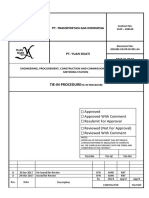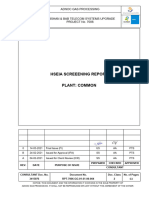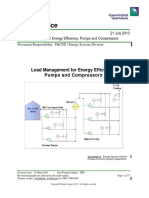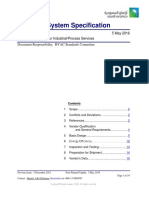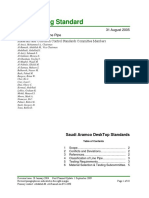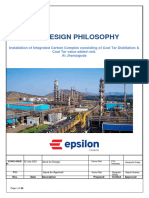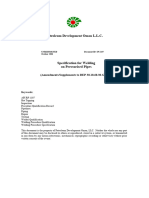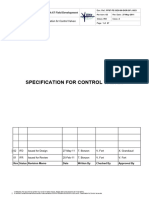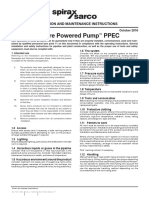GSW NG01017640 GEN LA7880 00003 - Technical Specifications For Barred Tee - D01
GSW NG01017640 GEN LA7880 00003 - Technical Specifications For Barred Tee - D01
Uploaded by
Justice NnamdiCopyright:
Available Formats
GSW NG01017640 GEN LA7880 00003 - Technical Specifications For Barred Tee - D01
GSW NG01017640 GEN LA7880 00003 - Technical Specifications For Barred Tee - D01
Uploaded by
Justice NnamdiOriginal Title
Copyright
Available Formats
Share this document
Did you find this document useful?
Is this content inappropriate?
Copyright:
Available Formats
GSW NG01017640 GEN LA7880 00003 - Technical Specifications For Barred Tee - D01
GSW NG01017640 GEN LA7880 00003 - Technical Specifications For Barred Tee - D01
Uploaded by
Justice NnamdiCopyright:
Available Formats
The Shell Petroleum Development Company of Nigeria Ltd
Originator LEE ENGINEERING & CONSTRUCTION. CO. LTD
Project GBARAN SINGLE WELLS OPPORTUNITY PROJECT -
INSTALLATION OF FACILITIES
Document Title TECHNICAL SPECIFICATION FOR BARRED TEE
Document Number GSW-NG01017640-GEN-LA7880-00003
DCAF Control ID NA
Security Classification Restricted
Owning Discipline LA Pipelines.
Month/Year Sept/2021
Proprietary Information: This document contains proprietary information and may not be partly or wholly
reproduced without prior written permission from Shell Petroleum Development Company.
Revision Date Description Originator Checker Approver
D01 9/9/2021 Issue for Review Nnamdi Kenneth Sanni
Umezuruike Aloziem Musa
ADDITIONAL AGREEMENT/APPROVAL RECORD
Party Ref Ind Name Sign Date
Revision Philosophy
All revisions for review will be issued at R01, with subsequent R02, R03, etc as required.
All revisions approved for issue or design will be issued at A01, with subsequent A02, A03,
etc as required.
Documents approved for Construction will be issued at C01, C02, and C03 respectively.
Documents or drawings revised as “As built” will be issued as Z01, Z02 Z03 etc.
Narrative sections revised from previous approved issues are to be noted in the table
below and/or highlighted in the RH margin (using the appropriate revision status) thus: |
A02
Previous revision highlighting to be removed at subsequent issues.
Drawings/diagrams revised from previous approved issues are highlighted by 'clouding'
the affected areas and the use of a triangle containing the revision status.
Revision History
Revision No. Date of issue Reason for change
Page 1 of 27
This document is controlled electronically and is uncontrolled when printed
D01 09/09/2021 Issue for Review
CONTENTS
1 INTRODUCTION 4
1.1 Project Description 4
1.2 Project Scope 4
2 GENERAL 7
2.1 Document Objectives 7
2.2 Scope of Document 7
2.3 Abbreviations and Acronyms 7
2.4 Terms and Definitions 9
2.5 References Document 10
2.5.1 Project References, Codes and Standards 10
2.5.2 International References, Codes and Standards 10
3 APPLICABLE REGULATIONS, SHELL DEPS, CODES AND STANDARDS 13
3.1 Nigerian Standards and Regulations 13
3.2 Shell DEPs 14
4 ORDER OF PRECEDENCE 14
5 ENVIRONMENTAL DESIGN CRITERIA 15
5.1 General 15
5.2 Site Environmental Data 15
6 DESIGN REQUIREMENTS 16
6.1 General 16
6.2 Dimensions 16
6.3 Design Calculations 17
7 MANUFACTURE PROCEDURE QUALIFICATION 17
Page 2 of 27
This document is controlled electronically and is uncontrolled when printed
7.1 Previous Experience 17
7.2 Manufacturing Procedure 17
8 MATERIAL REQUIREMENTS 18
8.1 Manufacture 18
8.2 Heat Treatment 19
9 WELDING 19
9.1 General 19
9.2 Defect Repair 19
10 TESTING AND INSPECTION 20
10.1 General 20
10.2 Mechanical Testing 20
10.3 Re-Tests 20
10.4 Visual Inspection 20
10.5 Magnetic Particle Inspection 20
10.6 Ultrasonic Examination 21
10.7 Hydrostatic Pressure Testing 21
11 MARKING AND PACKING 21
11.1 Identification 21
11.2 Preparation for Shipment 22
12 QUALITY ASSURANCE 22
12.1 General 22
12.2 Quality Control Plan 22
13 CERTIFICATION 22
14 APPENDIX 1 MECHANICAL TEST LOCATION 24
15 APPENDIX 2: BARRED TEE DESIGN REQUIREMENT 25
16 APPENDIX 3: INSPECTION DATA SHEET (IDS) 26
Page 3 of 27
This document is controlled electronically and is uncontrolled when printed
17 APPENDIX 4: REQUIRED DOCUMENTS DATA SHEETS (RDDS) 27
1 INTRODUCTION
1.1 Project Description
The Gbaran-026 Hook-up and F1B/ F22B Gas Development opportunity is part of SPDC’s Single
Wells opportunities portfolio for quick win delivery of gas to fill the gap in Shell JV export gas
value stream (NLNG T1 -T6) from 2020 at competitive CAPEX. The opportunity entails
developing 284.9 Bscf of gas and 11.7 MMstb of condensate from the Gbaran F1000B and F2200B
reservoirs. The GBAR-026 well, drilled in 2015, is part of SPDC’s campaign to explore and develop
High Pressure High Temperature (HPHT) reservoirs around the Gbaran Area in a bid to increase
its hydrocarbon resource volumes and increase the robustness of gas supply to NLNG by early
hook-up to production through the Gbaran CPF. The drilling of Gbaran-026 confirmed the
presence of hydrocarbon in the F2200B reservoir and was also used to appraise the already proven
F1000B reservoir. It is proposed to drill a second NAG well (Gbaran-F1F22) from the Gbaran
23/25/26 well cluster to carry out a 6-month Extended Well Test (EWT) of the F2200B reservoir
through the Gbaran CPF. Data gathered during the EWT will be used to develop and secure
approval for the F2200B RDP. Subsequently, the F2200B reservoir will be fully developed by
producing through the Gbaran CPF. Once F2200B is depleted, the Gbaran-F1F22 well will be re-
completed to target the crestal volumes on F1000B.
The Gbaran-026 Hook-up and F1B/ F22B Gas Development opportunity involves the following:
Drilling of GBAR-F1F22 NAG well from the GBAR-23/25/26 well cluster and initial
completion on F2200B to develop 49 Bscf of gas and 1.6 MMstb of condensate. When
F2200 is depleted, the well will be re-completed on the shallower F1000B reservoir to
develop 160 Bscf of gas and 5 MMstb of condensate.
Completion of GBAR-026 on the F1000B reservoir to develop 79.5 Bscf of gas and 2.7
MMstb of condensate.
Laying of 10” x 5km bulk line from the Gbaran well cluster to Gbaran CPF and tie-in of
the 2 wells (GBAR-026 and BGAR-F1F22) to the bulk line via standardized HPHT well
hook-up system for production through the CPF.
Laying of 48core FO cable from CPF to Gbaran NAG FAR and from the FAR to the
Hook-up skids
1.2 Project Scope
The GBAR-26 is located at the existing GBAR-23/25 wells cluster. The GBAR-F1F22 well will
also be drilled from this cluster. The project scope involves the following:
Complete the GBAR-26 well (located at GBAR-23/25/26 well cluster) on the F2200
reservoir.
Drill the GBAR-F1F22 well from the GBAR-23/25/26 well cluster and complete the well
initially on the F2200 reservoir.
Page 4 of 27
This document is controlled electronically and is uncontrolled when printed
Lay 2 nos. 6” x 50m API 15,000 series SDSS flowlines from the GBAR-26 and GBAR-
F1F22 wells to their individual HPHT skids. Based on learnings from K2S, pipe routing
should be done in such a way to minimise the length between wells and the auto choke,
hence reducing the impact of pressure settle out across the HP (15000#) and LP (2500#)
section on downstream equipment during OSD/ESD.
Fabricate and install 2 nos HPHT skids (skid mounted well hook-up modules) at the
wellhead location (1 skid per well). Each well hook-up skid should consist of the following:
o A 15,000psi rated, 6“SDSS flowline (Maximum wells CITHP of 12,500psi, but
standardised to 15,000psi for SPDC wide HPHT wells)
o A 15,000psi series integral mechanical HIPPS system.
o A 15,000psi rated automated choke valve for flow/pressure control.
o A 15,000psi manual choke valve system for start-up.
o An ANSI 2500# Wet gas flow meter – preferably a dual venturi type or One
Subsea meter which does not require properties of the mixed stream but only
properties of the single phase for calibration.
o Gas sample connection point
o Automated sand detectors
o sand trap
o Earthing &Bonding
o Rectifier for DC power supply to Well Head Control Panel
o Vent pipe equipped with integrated liquid knock-out /maintenance drain tank.
Skid-edge/sidemounted lighting fittings for illuminating the skid area.
o Electrical and Instrumentation cabinet (to serve as Field Auxiliary Room – FAR)
o Lightning protection system
Lay 2 nos. 6” x 20m 2500# DSS flowlines from the Gbaran-26 and Gbaran-F1F22 HPHT
skids to the new bulkline
Provision of a new 15,000psi rated mobile well equalization package at the well location
Lay 10-inch x 5km DSS bulk line with pig traps from the HPHT skid to Gbaran CPF
Install a tee for tie-in of GBAR-F1F22 & Gbaran-26 wells before the shutdown valve on
the bulk line.
Tie-in the new bulk line to the Gbaran NAG slug catcher inlet header at the CPF
Install shutdown valve on the bulk line at Gbaran CPF end
Install chemical injection system for pressure equalisation and hydrate inhibition
Tie-in the well control system to the Gbaran CPF Process Automation System
Tie-in pipeline isolation system to the Gbaran CPF Safety Instrumented System as shown
below;
Tie-in electrical power from the existing LV switch at the adjacent Gbaran remote
manifolds FAR.
Page 5 of 27
This document is controlled electronically and is uncontrolled when printed
Integrate all functionalities in the new installations with the existing Gbaran CPF and
remote facilities
Terminate the E&I cabinet components to Well Head Control Panel, existing Gbaran
Remote FAR equipment, Gbaran CPF Process Automation/ Safety Instrumented System.
Figure 1 Gbaran-026 Hook-up and F1000B_F2200B Gas Development Process Schematic
Page 6 of 27
This document is controlled electronically and is uncontrolled when printed
2 GENERAL
2.1 Document Objectives
The objective of this document is to establish the guidelines to be followed when designing,
manufacturing, inspecting, testing and supplying of Barred Tee at Gbaran Single Wells
Opportunities Project
This specification when read in conjunction with the referenced standards, specifications, other
listed documents and relevant data sheets, defines the minimum technical requirements for the
design, manufacture, inspection, testing and supply of the 10” x 10” Duplex stainless steel barred
tees for the Gbaran Single Wells Opportunities Project
2.2 Scope of Document
This document covers the all requirements for the design, manufacture, testing, inspection,
preservation, packaging, transportation and supply of pipeline barred tees intended for Gbaran
Single Wells Opportunities Project. The barred tees shall be suitable for the specified operating
and environmental conditions for a period of 25 years. All barred tees shall be water, dust, fungus
and termite resistant.
The Barred shall be designed, manufactured, inspected, tested and supplied in accordance with this
specification and the referenced applicable codes and standards.
The SUPPLIER has to demonstrate the capabilities of supplying of Barred Tee as per this
specification; any deviation from this specification and all applicable references documents listed
at Sec.2.5.1, shall be clearly declared.
Object of this specification are the following items:
S/N Items Location. Size/mm (inch) Quantity
1 Barred Tee Gbaran CPF DN 250 (NPS 10) 1
Gbaran
2 Barred Tee DN 250 (NPS 10) 1
Manifold
2.3 Abbreviations and Acronyms
Abbreviations/Acronyms Meaning
ABS American Bureau of Shipping
AISC American Institute of Steel Construction
ANSI American National Standard Institute
API American Petroleum Institute
API RP American Petroleum Institute – Recommended Practice
API STD American Petroleum Institute – Standard
Page 7 of 27
This document is controlled electronically and is uncontrolled when printed
ASME American Society of Mechanical Engineers
ASTM American Society for Testing of Materials
BPVC Boiler and Pressure Vessel Code
BfD Gbaran Single Well Opportunities Basis for Design
CAPEX Capital Expenditure
CS Carbon Steel
CE Carbon Equivalent
CSWIP Certification Scheme for Welding and Inspection Personnel
CPF Central Processing Facility
DEP Shell Standard for Design and Engineering Practice
DFT Dry Film Thickness
DNV Det Norske Veritas
GTAW Gas Tungsten Arc Welding
GSW Gbaran Single Well
ISO International Standards Organisation
MMscf/d Million Standard Cubic Feet per Day
MMstb Million Stock Tank Barrels
MSDS Material Safety Data Sheet
MSS Manufacturers Standardization Society
NDE Non-Destructive Examination
NAG Non -Associated Gas
NLNG Nigeria Liquefied Natural Gas
NPS Nominal Pipe Size
PPE Personnel Protective Equipment
PWHT Post Weld Heat Treatment
PQR Procedure Qualification Record
PQT Procedure Qualification Trial
PTFE Polytetrafluoroethylene
Page 8 of 27
This document is controlled electronically and is uncontrolled when printed
QCP Quality Control Plan
SAW Submerged Arc Welded
SMAW Shielded Metal Arc Welded
SMYS Specified Minimum Yield Strength
SPDC Shell Petroleum Development Company of Nigeria Limited
WPS Welding Procedure Specification
2.4 Terms and Definitions
Company/Shell/SPDC Shell Petroleum Development Company of Nigeria Limited
Principal Party (Usually SPDC), that initiates the project and ultimately pays
for its design and construction. The Principal will generally specify
the technical requirements. The Principal may also include an agent
or consultant authorised to act for and on behalf of, the Principal.
Contractor Party, which carries out all or part of the detail design. The Principal
may undertake all or part of the duties of the Contractor.
Manufacturer/Supplier Party, which manufactures or supplies equipment and services to
perform the duties specified by the Contractor.
Inspection Set of verification process used to confirm that products and goods
delivered are the same as those requested for, and the physical
condition of the products is acceptable
Procurement Includes Purchasing (products, goods) and Subcontracting
(Services)
Project Gbaran Single Well Opportunities (GB-026_F1B_F22) Project
Shall Indicates mandatory requirement.
Should Indicates preferred course of action or a recommendation.
Supplier/Vendor The person or firm of company whose tender has been accepted
and includes the Vendor’s duly appointed representatives,
successors and permitted assigns.
Traceability The ability to trace the history, application, or location of an item
and like items or activities by means of recorded identification.
Page 9 of 27
This document is controlled electronically and is uncontrolled when printed
2.5 References Document
2.5.1 Project References, Codes and Standards
Document Number Document Title
GSW-NG01017640-GBRS1-AA5798-00001 Project Execution Plan
GSW-NG01017640-GBRS1-AA5787-00001 Feed Verification Report
GSW-NG01017640-GBRS1-JA6611-00001 Master Document Register
GSW-NG01017640-GBRS1-JA6017-00002 Document Control Procedure
GSW-NG01017640-GBRS1-QA5798-00003 Project Quality Plan
GSW-NG01017640-GBRS1-QA6050-00004 Welding Procedure Specifications
GSW-NG01017640-GEN-LA6180-00008 Pipeline Hydro testing Procedure
GSW-NG01017640-GBRG1-LA1380-00001 Calculation Report for Pig Receiver
GSW-NG01017640-GBRS1-LA1380-00001 Calculation Report for Pig Launcher
GSW-NG01017640-GBRG1-LA1380-00001 Mechanical Datasheet for Pig Launcher
GSW-NG01017640-GBRS1-LA2105-00002 Mechanical Datasheets for Pig Receiver
GSW-NG01017640-GEN-LA7880-00001 Material Specification for Line Pipes
GSW-NG01017640-GBRG1-LA4018-00001 General Arrangement for Pig Receiver
GSW-NG01017640-GBRS1-LA4018-00001 General Arrangement for Pig Launcher
GSW-NG01017640-GEN-LA2105-00001 Pipeline Valve Datasheet
GSW-NG01017640-GBRS1-LA4024-00001-001 Above Ground Pipeline Support Detail
SWO-SCiNDO-GBRS1-PX2365-10003-001 PEFS Nag Pig Launcher
SWO-SCiNDO-GBRG1-PX2365-10004-001 PEFS Nag Pig Receiver
2.5.2 International References, Codes and Standards
These are the various International requirements, inputs, procedures and specifications, design
basis/philosophy which are required for the execution of the project, details are as follows:
Document Number Document Title
ASME B31.8 Gas Transmission and Distribution Piping Systems
ASME B31.3 Process Piping
ASME Section VIII Div. 1 Boiler and Pressure Vessel Code
Page 10 of 27
This document is controlled electronically and is uncontrolled when printed
ASME B1.20.1 Pipe Threads, General Purpose (Inch)
ASME Sec IX Welding and Brazing Qualifications
ASME Sec V Boiler and Pressure Vessel Code; Section V; Non-
Destructive Examination
ASME Sec II Boiler & Pressure Vessel Code – Materials
ASME B16.5 Pipe Flanges & Flanged Fittings
ASME B16.9 Factory-Made Wrought Butt-Welding Fittings
ASME B16.20 Ring Joint gaskets and Grooves for Steel Pipe Flanges
API STD 1104 Welding of Pipelines and Related Facilities
API RP 1110 Recommended Practice for the Pressure Testing of Steel
Pipelines for the Transportation of Gas, Petroleum Gas,
Hazardous Liquids, Highly Volatile Liquids, or Carbon
Dioxide
API RP 520 Sizing, Selection, and Installation of Pressure-Relieving
Devices in Refineries
API RP 505 Recommended Practice for Classification of Locations for
Electrical Installations at Petroleum Facilities Classified as
Class I, Zone 0, Zone 1, and Zone 2
API SPEC 6D Specification for Pipeline Valves
API SPEC 5LC Specification for Line Pipe
ASTM A790/A790M Standard Specification for Seamless and Welded
Ferritic/austenitic Stainless Steel Pipes
ASTM A312/A312M Standard Specification for Seamless and Welded Austenitic
Stainless-Steel Pipes
ASTM A 358/A 358M Standard Specification for Electric-Fusion-Welded
Austenitic Chromium-Nickel Alloy Steel Pipe for High-
Temperature Service
ASTM A370/A370M Standard Test methods and Definitions for Mechanical
Testing of Steel Products
ASTM A 671/A 671M Standard Specification for Electric-Fusion-Welded Steel
Pipe for Atmospheric and Lower Temperatures
Page 11 of 27
This document is controlled electronically and is uncontrolled when printed
ASTM A182/A182M Standard Specification for Forged or Rolled Alloy and
Stainless-Steel Pipe Flanges, Forged Fittings, and Valves
and Parts for High Temperature Service
ASTM A 815/A 815M Standard Specification for Wrought Austenitic Duplex
Stain steel Piping Fittings
ASTM A 350/A 350M Standard Specification for Carbon and Low-Alloy Steel
Forgings, Requiring Notch Toughness Testing for Piping
Components
ASTM A403/A403M Standard Specification for Wrought Austenitic Stainless
Steel Piping Fittings
ASTM A320/A320M Standard Specification for Alloy-Steel and Stainless-Steel
Bolting for Low-Temperature Service
ASTM. A193/A193M Standard Specification for Alloy-Steel and Stainless-Steel
Bolting for High Temperature or High-Pressure Service
and Other Special Purpose Applications
ASTM A194/A194M Standard Specification for Carbon Steel, Alloy Steel, and
Stainless-Steel Nuts for Bolts for High Pressure or High
Temperature Service, or Both
ASTM E709 Standard Guide for Magnetic Particle Examination
BS 1133 Packaging Code
BS 2633 Specification for Class 1 Arc Welding of Ferritic Steel
Pipework for Carrying Fluids
BS 4515 Specification for Welding of Steel Pipelines on Land and
Offshore. Carbon and Carbon Manganese Steel Pipelines
BS CP 3012 Cleaning and Preparation of Metal Surfaces
BS EN 10045-1 Charpy Impact Test on Metallic Materials. Test Method (V-
and U-Notches)
BS EN 462-1 Non-Destructive Testing. Image Quality of Radiographs.
Image Quality Indicators (Wire Type). Determination of
Image Quality Value. Part 1
BS EN 473 Non-Destructive Testing. Qualification and Certification
of NDT Personnel. General Principles.
BS PD 5500 Specification for Unfired Fusion Welded Pressure Vessels
BPVC Section V Non Destructive Examination
Page 12 of 27
This document is controlled electronically and is uncontrolled when printed
BPVC Section IX Welding and Brazing Qualifications
PCN-CSWIP NDT and Welding Certifications of British Institute of
Non-Destructive Testing and the Welding Institute
SNT TC-1A Personnel Qualification and Certification in Non-
destructive Testing
BS EN 10204 Metallic Products – Types of Inspection Documents
NACE MR-0175 Sulphide Stress Corrosion Cracking Resistant Materials for
Oil Field Equipment
ISO 13623 Petroleum and Natural Gas Industries – Pipeline
Transportation Systems
ISO 3183-3 Petroleum and Natural Gas Industries -- Steel Pipe for
Pipelines -Technical Delivery Conditions – Part 3: Pipes of
Requirement Class C
ISO 9001 Quality system – Model for quality assurance in design,
development, production, installation and servicing.
EN 10204 Metallic Products – Type of Inspection documents.
MSS –SP 44 Steel pipeline Flanges
MSS-SP 75 Specification for high –Test Wrought Butt-welding fittings
API 520/521 Sizing, Selection, and Installation of Pressure- Relieving
Devices in Refineries/Guide for Pressure – Relieving and
Depressurizing System
AWS D1.1 Structural Welding Code
EGASPIN Environmental Guidelines and Standards for Petroleum
Industry in Nigeria
3 APPLICABLE REGULATIONS, SHELL DEPS, CODES AND STANDARDS
3.1 Nigerian Standards and Regulations
Petroleum Act of 1969, The Mineral Oils (Safety) Regulations, latest revision
Environmental Guidelines and Standards for the Petroleum Industry in Nigeria, 2002,
latest revision, issued by DPR
Applicable Department of Petroleum Resources (DPR) Regulations and Guidelines
S.I.14, Federal Republic of Nigeria Official Gazette Notice No.49, Oil and Gas Pipe Lines
Regulations 1995
Page 13 of 27
This document is controlled electronically and is uncontrolled when printed
DPR P-1P Guidelines and Procedures for the Design, Construction, Operation and
Maintenance of Oil and Gas Pipeline systems in Nigeria (2007)
3.2 Shell DEPs
Document Number Document Title
DEP 30.10.73.31-Gen Design of cathodic protection systems for onshore buried
pipelines and on-plot piping (amendments/supplements
to ISO 15589-1:2003)
DEP 31.38.01.29-Gen Pipe supports
DEP 31.40.00.10-Gen. Pipeline engineering
DEP 31.40.10.13-Gen Design of pig trap systems
DEP 31.40.20.30-Gen Line pipe for use in oil and gas operations under non-sour
conditions
DEP 31.40.20.33-Gen Line pipe induction bends
DEP 31.40.21.30-Gen Pipeline fittings
DEP 31.40.40.38-Gen Hydrostatic pressure testing of new pipelines
DEP 31.40.50.30-Gen Pre-commissioning of pipelines
DEP 30.48.00.31-Gen Protective Coatings for Onshore and Offshore Facilities
DEP 61.40.20.30-Gen Welding of pipelines and related facilities
4 ORDER OF PRECEDENCE
All materials to be supplied under this specification shall conform to the requirements specified
herein. In the event of any conflict between specification, data sheets, codes and standards, then
the following precedence shall apply.
This Specification
Other Relevant Project Specification
International Code and Standards.
National/ Local Codes and Standards
Nigerian Government Legislation
Project Scope of Work
Shell DEPs and Standards
Page 14 of 27
This document is controlled electronically and is uncontrolled when printed
5 ENVIRONMENTAL DESIGN CRITERIA
5.1 General
All equipment and components in the Scope of Supply shall meet the design and operational
requirements when subjected to the environmental conditions listed below as a guide.
The data listed below give an overview of the conditions prevalent in the Project area.
The project area is situated in the Niger Delta. Drainage in this area is particularly poor in the April
to October rainy season.
The following meteorological conditions (as taken from the Project Basis for Design Doc. BFD
doc. No; SWO-SCiNDO-GEN-AA7704-00001) exist in the project area:
5.2 Site Environmental Data
Air Temperature
Mean minimum temperature : 23°C
Minimum temperature : 18°C (Design Value)
Mean maximum temperature : 31°C
Maximum temperature : 38°C (Design Value)
Minimum swamp temperature : 25°C (NB 23°C to be used wherever a margin is required)
Ground temperature : 25 -27.5°C
Black-bulb temperature for oil : 80°C (Design Value)
Humidity : 45 - 100% (Design Value at 100%)
Rainfall
Heavy rainfall can be expected in the wet season during months of April through October.
Average annual rainfall :3800mm
Mean maximum hourly rainfall :100mm
Wind speed & direction
Design wind speed : 35.6m/s
Location specific wind direction data and other detailed information are available in the Gbaran
Ubie EIA report
Entomology and Vermin:
This is prevalent in Niger Delta areas with thick forest and swamp habitat.
Fungi and Growths:
Page 15 of 27
This document is controlled electronically and is uncontrolled when printed
This is prevalent in Niger Delta areas with thick forest and swamp habitat.
Lightning is very frequent in the rainy season. Dry (non-rainstorm) lightning is prevalent at
the start and the end of the rainy season.
The Niger delta is not classified as a seismic region and the design excludes any geo-technical
evaluation.
Oceanographic:
Not Applicable
Geotechnical
Refer to Gbaran Deep Location Geotechnical Investigation Survey Report
6 DESIGN REQUIREMENTS
6.1 General
Tees shall be designed to meet the requirements of ASME B31.8. Tees shall be designed to code
to withstand the forces and moments equivalent to the base pipe.
All tees shall be barred design, suitable for pigging in either direction through the run of the tee.
Reference shall be made to APPENDIX 1 & 2, – Barred Tee Design Requirements.
The bars shall be of the same material type and grade as the tee itself and shall be welded into the
branch of the tee via a carrier ring that is seal welded. Bars shall be full penetration welded into the
outlet branch after fabrication of the tee.
The design of the bars and their attaching welds shall be such that they can sustain a bi-directional
uniformly distributed load equivalent to the full test pressure of the tee multiplied by the internal
cross sectional area of the branch piping. (This load is equivalent to that which would be seen if a
pig were to become trapped in the branch of the tee with full test pressure on one side and no
pressure on the other).
Where required, the bars shall be recessed into the branch of the tee to sufficient depth to prevent
their hindering the passage of a pig but at the same time, at not such a depth as to allow a pig to
rotate and become trapped in the tee.
6.2 Dimensions
Dimensions and tolerances shall be in accordance with ASME B16.9, unless modified by the data
sheet. The diameters and wall thicknesses of the tee at each weld end shall be as shown on the data
sheet.
The tolerance on the nominal internal diameter, defined as the nominal external diameter minus
twice the nominal wall thickness, shall meet the requirements of ASME B16.9. Out of roundness
shall be assessed using an internal ring gauge of diameter 5mm less than the nominal internal
diameter and of length equal to 1.5 times its diameter shall be assumed.
Page 16 of 27
This document is controlled electronically and is uncontrolled when printed
A gauge shall pass freely through the barred tee when held normal to the pipe axis.
Weld ends shall be bevelled in accordance with ASME B16.9.
At the branch outlets the maximum wall thickness shall not exceed the nominal wall thickness by
more than 10%. Excess material shall be machined back at an angle not exceeding 14° (1 in 4
taper), all in accordance with ASME B31.8 Section 422.1 (a)-(b).
Run and branch connections shall be bevelled in accordance with ASME B16.9, to match the size
and wall thickness of the connecting pipes. The taper to accommodate the change in thickness
from line pipe shall be on the outside diameter of the fitting only. Internal bores shall match the
pipe.
6.3 Design Calculations
The SUPPLIER shall design each tee for the worst combination of temperatures, pressures, forces
and moments. COMPANY is to advise maximum forces and moments on tee.
The calculated wall thickness shall include for a corrosion allowance as specified on the applicable
data sheet.
Apart from the reinforcement areas, the barred tee ends will have the same nominal dimensions
as the flowline to which it is attached. The matching wall thickness of the line pipe shall be 9.53
mm nominal. The mating material shall be API 5LC in accordance with project specification.
Rules for the design and reinforcement of branch outlets are specified in ASME B31.8.
Any computer programs used for the work shall be fully verified.
SUPPLIER shall submit detail calculations for thickness and reinforcement together with drawings
to COMPANY for approval prior to start of manufacturing.
7 MANUFACTURE PROCEDURE QUALIFICATION
7.1 Previous Experience
Materials supplied to this Specification shall be supplied by companies who have had experience
in supplying similar welded fittings.
The SUPPLIER shall state in his bid the source of steel and place of manufacture.
The SUPPLIER shall submit the following information:
List of all sub-suppliers from steelmaking to finished product
Complete manufacturing procedure(s) covering all steps from steelmaking to finished
fittings and the quality controls for each step
7.2 Manufacturing Procedure
The SUPPLIER shall submit, for COMPANY acceptance, a detailed Manufacturing Procedure for
the tees incorporating all the requirements of this Specification. This shall include procedures for
steelmaking, chemical composition, casting, forging, heat treatment, weld overlay, machining,
Page 17 of 27
This document is controlled electronically and is uncontrolled when printed
mechanical testing, inspection and NDT, surface finish (internal and external), quality control and
assurance and material traceability for each manufacturing location.
The Manufacturing Procedure shall be submitted immediately after Purchase Order (PO) raised
and contract award, prior to a pre-production meeting.
8 MATERIAL REQUIREMENTS
8.1 Manufacture
Forged tees shall be manufactured by a hot forging process in accordance with ASTM A815 UNS
S31803 and shall be suitable for welding to line pipe manufactured in accordance with API 5LC.
Tees shall be forged into shape such that finishing of the forgings may be achieved with the
minimum of machining.
Unless otherwise agreed by the COMPANY, all tees shall be from the same heat (cast) of steel and
the same heat treatment batch.
Materials used in the manufacture of the tees may be forged or seamless carbon steel pipe material.
Steels shall be made from a basic oxygen process or electrical arc furnace method. Only fully killed
fine grain steels shall be used. The steel shall be of carbon or carbon manganese based composition.
The mechanical testing schedule and specimen location shall be as agreed by the COMPANY. The
mechanical properties of the material shall be as follows:
Yield Strength 448N/mm2 (minimum)
Tensile Strength 620N/mm2 (minimum)
Elongation % of 50mm specimen 25% (minimum)
The testing procedure shall be in accordance with ASTM A370.
The impact toughness of the tees shall be determined by Charpy V-notch (CVN) impact testing in
accordance with ASTM A370, using full-size specimens where possible. Three Charpy specimens
shall be taken from the parent metal at locations agreed by the COMPANY.
The impact test temperature shall be lower than or equal to the minimum design temperature, as
specified in the data sheet.
For approval testing, specimen location and orientation shall be longitudinal.
For production quality control testing, specimens may be taken from forging prolongations. The
specimen orientation shall be tangential.
The Charpy energy acceptance criterion shown is for full size 10mm x 10mm specimens. Where
sub-size specimens are used, the energy acceptance criteria may be adjusted proportionally.
Page 18 of 27
This document is controlled electronically and is uncontrolled when printed
8.2 Heat Treatment
Tees shall be supplied in one of the heat-treated conditions:
Normalized
Normalized and Tempered
Normalized, Quenched and Tempered
SUPPLIER shall advise COMPANY of the heat treatment to be applied with his bid.
Heat treatment shall be such to ensure the mechanical properties specified in Section 8.1. All
thermo / mechanical treatment of material shall be subject to review and acceptance by
COMPANY.
There shall be at least one thermocouple connected directly to the barred tee during heat treatment.
9 WELDING
9.1 General
Welds, including welding of guide bars in tees, shall be made according to procedures qualified to
the requirements of ASME IX.
All welds on barred tees for guide bars and attaching guide bars to the branch of the tee shall be
full penetration and continuous around the guide bars.
9.2 Defect Repair
No repair work shall proceed without prior written authorisation from the COMPANY. Repairs
of forgings by welding shall not be permitted.
Surface defects such as slivers, sharp notches, gouges, scores, pits and severe machining marks
shall be considered injurious defects and in need of repair. Minor surface defects may be removed
by machining or grinding, where the wall thickness is not reduced locally by more than 5% of the
nominal thickness, and when the minimum specified wall thickness is maintained. The remaining
wall thickness shall be verified to the satisfaction of the COMPANY using ultrasonic or other
calibrated instruments.
The machined or ground area(s) shall be carefully dressed to ensure smooth transition with the
surrounding surface of the forging with no sharp notches or contours.
The machined or ground area(s) shall be examined for any defects using magnetic particle
examination. Magnetic Particle Inspection (MPI) shall be carried out in accordance with ASME
Section V / ASTM E709.
If the section thickness is reduced below the minimum section thickness required in accordance
with this Specification, the tee shall be rejected.
Page 19 of 27
This document is controlled electronically and is uncontrolled when printed
Cracks shall not be repaired and shall be cause for rejection. The cause of cracking shall be
investigated and established to the satisfaction of the COMPANY.
10 TESTING AND INSPECTION
10.1 General
SUPPLIER will carry out inspection as detailed in this Specification. This inspection does not
remove SUPPLIER from the responsibility to perform inspection activities sufficient to ensure
the quality of the product.
SUPPLIER inspectors and equipment are subject to the approval of COMPANY. COMPANY
will be the sole judge of the acceptability of materials and/or work done.
Personnel carrying out non-destructive inspection shall be experienced in using the equipment
specified and shall be qualified to a minimum of ASNT SNT-TC-1A Level II, ISO 9712 or
COMPANY agreed equivalent.
The person responsible for the preparation of inspection procedures and supervision of inspection
activities shall be qualified to ASNT SNT-TC-1A Level II, ISO 9712 or COMPANY agreed
equivalent.
10.2 Mechanical Testing
Mechanical tests for the tees shall be carried out on test pieces cut from full size test forging in
accordance with COMPANY accepted locations shown in APPENDIX 1.
Mechanical tests shall be carried out on test pieces cut from a test item of each material grade, heat
treatment batch. For small items from which a complete suite of test pieces cannot be cut, the
SUPPLIER shall propose test locations that can provide the requisite mechanical test data as
appropriate to the specific geometry.
10.3 Re-Tests
If any of the results does not conform to the specified requirements, the SUPPLIER may heat-
treat the batch forgings again provided they have COMPANY acceptance. The material shall then
be tested in accordance with this Specification.
10.4 Visual Inspection
All tees, including bevelled ends, shall be subject to 100% visual inspection to ensure freedom
from surface defects and compliance with dimensional tolerances.
10.5 Magnetic Particle Inspection
100% magnetic particle examination shall be carried out on all external surfaces of the finished tee
after heat treatment and final machining.
Magnetic Particle Inspection (MPI) shall be carried out as follows:
Page 20 of 27
This document is controlled electronically and is uncontrolled when printed
Procedure: ASME V / ASTM E709
Acceptance: ASME VIII Div. 1
No indications will be permitted on bevelled ends. All indications shall be removed by cutting back
or grinding and subject to re-examination by magnetic particle examination.
Acceptance criteria for girth welds, such as those for attachment of pup-piece to fittings shall be
in accordance with API STD 1104.
10.6 Ultrasonic Examination
The tees shall be subject to 100% ultrasonic examination which shall be carried out as follows:
Procedure: ASME V
Acceptance: ASME VIII Div. 1
10.7 Hydrostatic Pressure Testing
The SUPPLIER shall certify to the COMPANY that each tee is capable of withstanding, without
leaks, ruptures or unacceptable deformation, the pipeline hydrostatic test pressure as specified on
the data sheet.
11 MARKING AND PACKING
11.1 Identification
The tees shall be marked in accordance with ANSI B16.9. Permanent marking shall be by low
stress or dot dye hard stamping or vibro etching.
Each tee shall be identified by markings, as a minimum of 25mm in height, applied in the sequence
detailed below:
COMPANY and Project Name
Suppliers Name
Purchase Order No. and Purchase Order Item No.
Tag / SP Number
Material Grade
Design Pressure
Nominal diameter and wall thickness
Heat number
Any fitting Quenched and Tempered during manufacture shall be marked ‘QT’ and HARD
STAMPED using round nose low stress stamping. Details of temperatures and times of heat
treatments shall be recorded on the certification.
Page 21 of 27
This document is controlled electronically and is uncontrolled when printed
11.2 Preparation for Shipment
SUPPLIER shall prepare the tees for shipment after all inspection and testing has been completed
and the COMPANY’s representative has approved them for shipment.
Packing shall be in accordance with procedures prepared and submitted by the SUPPLIER and
accepted by the COMPANY. SUPPLIER shall submit a procedure detailing his method of packing
and shipping of all items, plus short (6 months) and long-term storage conditions, for COMPANY
review and acceptance.
All openings shall be provided with end caps to prevent the entrance of moisture or foreign
materials and damage to the bevel ends.
12 QUALITY ASSURANCE
12.1 General
All certification, test results, reports, and any other documentation submitted to the COMPANY
relative to the inspection system and results of inspections shall be in English language.
The CONTRACTOR shall establish and maintain a fully documented Quality System in
accordance with ISO 9001.
12.2 Quality Control Plan
Prior to the commencement of the work, the CONTRACTOR shall prepare a written Quality
Control plan that describes the inspection to be carried out on each contract or product. The
Quality Control plan, reference procedures and changes thereto are subject to the approval of the
COMPANY.
13 CERTIFICATION
A certification to BS EN 10204 3.2 is required, containing, as a minimum:
Purchaser Order Number
Purchase Order Item Number/Sub-item Number
SUPPLIER Identification
Nominal Size
Material Designation and Specification Number
Heat or Melt Number
Steel Making Process
Heat Treatment
Results of all Specified Tests and Examinations
Welding Procedures
Page 22 of 27
This document is controlled electronically and is uncontrolled when printed
Hydrotest Certificate
NDE Results
Certificates of the starting material to BS EN 10204 3.2, shall be enclosed with the certificates
issued by the fitting SUPPLIER.
Page 23 of 27
This document is controlled electronically and is uncontrolled when printed
14 APPENDIX 1 MECHANICAL TEST LOCATION
Page 24 of 27
This document is controlled electronically and is uncontrolled when printed
15 APPENDIX 2: BARRED TEE DESIGN REQUIREMENT
Page 25 of 27
This document is controlled electronically and is uncontrolled when printed
16 APPENDIX 3: INSPECTION DATA SHEET (IDS)
INSPECTION DATA SHEET
MATERIAL: BARRED TEE CLASS OF PRODUCT
SURVEILLANCE TYPE PARTIES
A = COMPANY (SPDC)
H = COMPULSORY PRESENCE. The production cycle is tied to this C = CONTRACTOR
presence S = SUPPLIER/VENDOR
P = COMPULSORY PRESENCE IN THE
PERCENTAGE INDICATED IN THE NOTE Reference Standard Codes & Specifications-Drawings
DEP 31.40.10.13-Gen Design of Pig Trap systems
Technical Specification for Pig Launcher and Receiver
W = NOT COMPULSORY PRESENCE. In the event of absence the
Doc No:GSW-NG01017640-GBRG1-LA7880-00001
Supplier is authorised to continue the production cycle supplying
General Arrangement Drawing for Pig Receiver
adequate certification
Doc No: GSW-NG01017640-GBRG1-LA4018-00001-001
R = CHECK OF CERTIFICATES AND/OR DOCUMENTS
C = CHECK PERFORMED WITH ISSUE OF CERTIFICATE
N = CHECK PERFORMED WITH NO ISSUE OF CERTIFICATE
D = DOCUMENTATION TESTING AUTHORITY:
PARTIES NOTES
No. INSPECTION AND TESTS
S C A
1 MANUFACTURING PROCEDURE SPECIFICATION
N R
(including INSPECTION AND TEST PLAN)
2 MATERIAL INSPECTION
2.1 CHEMICAL ANALYSIS (Raw material certificates) C W
2.2 MATERIAL MECHANICAL TESTS C W
3 PRODUCTION INSPECTION
3.1 HEAT TREATMENT CERTIFICATE (if applicable) C W
4 NON DESTRUCTIVE EXAMINATIONS
4.1 X-RAY (RT) OR UT ON PIECE ENDS C W
4.2 MT OR PT INSPECTION C W
5 HYDROSTATIC TEST (if applicable) C W
6 VISUAL INSPECTION AND DIMENSIONAL VERIFICATION N W
7 EXTERNAL PROTECTION OF FLANGE CONTACT SURFACE N W
8 MARKING CHECK N W
9 THICKNESS CHECK C W
10 PAINTING CHECK C W
11 PACKAGING INSPECTION C W
12 QC DATA BOOK D R
13 CERTIFICATE OF COMPLIANCE TO CONTRACTUAL REQUIREMENTS D R
14 PRE-INSPECTION MEETING WITH NAOC IN ATTENDANCE H H H
15 FINAL DOCUMENTATION REVIEW (DATA BOOK) D H H
Page 26 of 27
This document is controlled electronically and is uncontrolled when printed
17 APPENDIX 4: REQUIRED DOCUMENTS DATA SHEETS (RDDS)
WITH
QUOTATION WITH ORDER
POS. DESCRIPTION FOR APPROVAL FINAL REMARKS
NUMBER
OFF NUMBER WHEN NUMBER WHEN
OFF DUE OFF DUE
01 Detail supply description 3P
02 Illustrations and technical 3P
documentation
03 Documentation listed at section of 3P
this specification
04 Exceptions / deviations list 3P
05 Reference list for similar goods 3P
supplied
06 Complete equipment list with Sub- 3P
supplier list
07 Sub-vendor list 3P (1) 3P 3W
08 List of documents to be produced by 3P (1) 3P 3W
Manufacturer
09 Detailed work program 3P (1) 3P 3W
10 Inspection and test plan 3P 3W
11 Marking procedure 3P 3W
12 Documentations 5P (2)
13 Final production master book 5P (2)
containing Test Certificates, Inspection
reports, Product Qualification Tests,
etc.
P = PRINTS R = REPRODUCIBLE M = MICROFILM
NOTES: (1) PRELIMINARY
(2) 2 WEEKS After Supply
Page 27 of 27
This document is controlled electronically and is uncontrolled when printed
You might also like
- Orbit Actuator Manual LS TypeDocument99 pagesOrbit Actuator Manual LS Typetxlucky80100% (2)
- Workshop Layout SampleDocument44 pagesWorkshop Layout Sampleautocarewin89% (9)
- ICM-SU-5102-C.3 - Control ValvesDocument67 pagesICM-SU-5102-C.3 - Control ValvesShivani DubeyNo ratings yet
- ICM-SU-5140-C.1 - FlowDocument37 pagesICM-SU-5140-C.1 - FlowShivani Dubey100% (1)
- 02 Samss 012Document10 pages02 Samss 012bmkaleNo ratings yet
- Material Guide For Horizontal and Vertical In-Line PumpsDocument1 pageMaterial Guide For Horizontal and Vertical In-Line PumpsEr Bishwonath Shah100% (1)
- Content of Design Standard 4S-10.01: Manufacture and Installation Specification For FRP StructuresDocument29 pagesContent of Design Standard 4S-10.01: Manufacture and Installation Specification For FRP StructuresJuan Ayala ValdebenitoNo ratings yet
- 5.2 Co2 Compression and Pumping PhilosophyDocument9 pages5.2 Co2 Compression and Pumping PhilosophyharryNo ratings yet
- Tie in Procedure Rev. BDocument8 pagesTie in Procedure Rev. BgenjiNo ratings yet
- Asn Gen 000000407Document40 pagesAsn Gen 000000407akintundeakinboladeNo ratings yet
- GSW NG01017640 GEN MP4033 00002 001 Piping Material SpecificationDocument114 pagesGSW NG01017640 GEN MP4033 00002 001 Piping Material SpecificationJustice NnamdiNo ratings yet
- RPT 7006 GG 01 61 00 004 0Document63 pagesRPT 7006 GG 01 61 00 004 0NikradNo ratings yet
- Datasheet For Pipeline Gate ValveDocument6 pagesDatasheet For Pipeline Gate ValveMohammed Azharuddin GNo ratings yet
- 32 Samss 019Document17 pages32 Samss 019Moustafa BayoumiNo ratings yet
- Sabp A 002Document57 pagesSabp A 002AdilNo ratings yet
- Saes L 130Document5 pagesSaes L 130Ahmed Kabel100% (1)
- 1 SATIP-E-007-01 Air Cooled HExch - Fin Fan-Rev 01Document2 pages1 SATIP-E-007-01 Air Cooled HExch - Fin Fan-Rev 01Anonymous S9qBDVkyNo ratings yet
- Materials System SpecificationDocument19 pagesMaterials System Specificationnadeem shaikhNo ratings yet
- Ad 036821 001Document1 pageAd 036821 001hai sunNo ratings yet
- Horizontal Directional Drilling Design Calculation Report - Rev.2Document22 pagesHorizontal Directional Drilling Design Calculation Report - Rev.2Robby TriNo ratings yet
- Specification For Hdpe (3lpe) Coating of Carbon Steel PipesDocument21 pagesSpecification For Hdpe (3lpe) Coating of Carbon Steel PipesDanish MohammedNo ratings yet
- 228 20 Pi DTS 00001Document16 pages228 20 Pi DTS 00001ritesh142No ratings yet
- Saes L 131Document10 pagesSaes L 131samsurendran_mech4020No ratings yet
- 4172-GENON-1-25-0019 - Rev 1Document16 pages4172-GENON-1-25-0019 - Rev 1Rajesh SinghNo ratings yet
- Onshore Pipelines - Preparation of The "As-Built" Drawings: Company SpecificationDocument12 pagesOnshore Pipelines - Preparation of The "As-Built" Drawings: Company Specificationbrahim amiraNo ratings yet
- National Oil Corporation: Rev Date Description Checked ApprovedDocument23 pagesNational Oil Corporation: Rev Date Description Checked ApprovedRochdi SahliNo ratings yet
- 60-01-11-2617 Rev 00Document121 pages60-01-11-2617 Rev 00KalpeshJadhavNo ratings yet
- S-000-1520-002 - 3b Quality Control Requirment To VendorDocument37 pagesS-000-1520-002 - 3b Quality Control Requirment To Vendorderi yuliantoNo ratings yet
- OMV E&P Philosophy: TitleDocument29 pagesOMV E&P Philosophy: TitleamdatiNo ratings yet
- 15-501-EP-DS-001 (Metering Skid Data Sheet), Rev.1Document2 pages15-501-EP-DS-001 (Metering Skid Data Sheet), Rev.1Umair A. KhanNo ratings yet
- Petronastechnicalstandards: Pipe SupportsDocument41 pagesPetronastechnicalstandards: Pipe SupportsEric TingNo ratings yet
- 02 - Samss ListDocument21 pages02 - Samss ListRijwan MohammadNo ratings yet
- ECAPL JSG HES Design PhilosophyDocument26 pagesECAPL JSG HES Design Philosophykanna gNo ratings yet
- GEN-RA7754-00003-R03 Specification For External Field Joint CoatingDocument28 pagesGEN-RA7754-00003-R03 Specification For External Field Joint CoatingNnamdi UmezuruikeNo ratings yet
- GEN-RA7754-00004-R03 Specification For Cathodic ProtectionDocument33 pagesGEN-RA7754-00004-R03 Specification For Cathodic ProtectionNnamdi UmezuruikeNo ratings yet
- Materials System SpecificationDocument13 pagesMaterials System SpecificationAli ALObaidNo ratings yet
- 20019.MAT - COR.PRG Selezione Maeriali Servizio Marino Rev. 0 - Aprile 2009Document45 pages20019.MAT - COR.PRG Selezione Maeriali Servizio Marino Rev. 0 - Aprile 2009Matteo100% (2)
- SA-7907Document2 pagesSA-7907Genard Sabenacio GarciaNo ratings yet
- Spec 2018-02 A00Document17 pagesSpec 2018-02 A00vikasamitabhNo ratings yet
- Petroleum Development Oman L.L.C.: (AMENDMENTS/SUPPLEMENTS TO ISO 15590-2: 2003)Document19 pagesPetroleum Development Oman L.L.C.: (AMENDMENTS/SUPPLEMENTS TO ISO 15590-2: 2003)Sapana MallaNo ratings yet
- 00 Saip 77Document6 pages00 Saip 77Shoaib NazirNo ratings yet
- 01-SAMSS-023 PDF - Intrusive Online Corrosion MonitoringDocument4 pages01-SAMSS-023 PDF - Intrusive Online Corrosion MonitoringZahidRafiqueNo ratings yet
- SP-1167-Specification For Welding On Pressurised PipesDocument11 pagesSP-1167-Specification For Welding On Pressurised Pipesarjunprasannan7No ratings yet
- STD 141Document31 pagesSTD 141Priyam KmNo ratings yet
- !indx SaerDocument1 page!indx SaerRiaz AhmadNo ratings yet
- Upbk ValDocument26 pagesUpbk ValRYZKI EFENDI SIMANULANGNo ratings yet
- Swing and Axial Flow Check Valves (Amendments/Supplements To Api 6D)Document16 pagesSwing and Axial Flow Check Valves (Amendments/Supplements To Api 6D)윤규섭No ratings yet
- DGS 1630-026 Rev 1Document33 pagesDGS 1630-026 Rev 1Muhmmad udassirNo ratings yet
- Tender Document - GAIL - MIJ PDFDocument17 pagesTender Document - GAIL - MIJ PDFVeer GangjiNo ratings yet
- Communication and Network Basis of Design - 240801 - 124602Document25 pagesCommunication and Network Basis of Design - 240801 - 124602AhmadNo ratings yet
- Vibration Induced Failure Avoidance and Management Around Vendor PackagesDocument24 pagesVibration Induced Failure Avoidance and Management Around Vendor PackagesJose Bijoy100% (1)
- SGGP Reference No: P0116-TAK-P01-0024-02Document11 pagesSGGP Reference No: P0116-TAK-P01-0024-02Jabel Oil Services Technical DPTNo ratings yet
- RFQ Line Pipe GTCLDocument43 pagesRFQ Line Pipe GTCLAJAY PatilNo ratings yet
- Saes L 136Document8 pagesSaes L 136kartik_harwani4387100% (1)
- PP67-PE-GEN-00-DOR-SP-J-023 - Rev02 - Specification For Control ValvesDocument27 pagesPP67-PE-GEN-00-DOR-SP-J-023 - Rev02 - Specification For Control Valvesmiguel angel bohorquez fajardoNo ratings yet
- Sabp J 900Document9 pagesSabp J 900kartik_harwani4387No ratings yet
- Saep 333Document46 pagesSaep 333Arun PrasadNo ratings yet
- Spec 2022-02 A00Document24 pagesSpec 2022-02 A00Anoop GokhaleNo ratings yet
- 32 Samss 021Document52 pages32 Samss 021mohdsameerabuallah5No ratings yet
- PGHU-CV-LBDES-000002 R3 Technical Spec For Pipes, Fittings, and Flanges - WG 22sep16Document28 pagesPGHU-CV-LBDES-000002 R3 Technical Spec For Pipes, Fittings, and Flanges - WG 22sep16Riyan EsapermanaNo ratings yet
- Ras Markaz Crude Oil Park Project (Phase1)Document67 pagesRas Markaz Crude Oil Park Project (Phase1)anil pkNo ratings yet
- Stress Analysis of A Gas Pipeline Installed Using HDD and Auger Bore TechniquesDocument8 pagesStress Analysis of A Gas Pipeline Installed Using HDD and Auger Bore TechniquesAmmarul Nafik100% (1)
- Eng052 20erw 002 PL Bod 0001 000 - 02Document42 pagesEng052 20erw 002 PL Bod 0001 000 - 02EngHamzaNo ratings yet
- GSW-NG01017640-GEN-LA7880-00003 - Technical Specifications For Barred Tee - D01Document27 pagesGSW-NG01017640-GEN-LA7880-00003 - Technical Specifications For Barred Tee - D01Nnamdi UmezuruikeNo ratings yet
- Module17 - Frequency Histoty DataDocument21 pagesModule17 - Frequency Histoty DataMinh ThưNo ratings yet
- Atsl-Cel-Pmt-Rpt-0000-00001 - Rev ADocument18 pagesAtsl-Cel-Pmt-Rpt-0000-00001 - Rev AOkoro KennethNo ratings yet
- Profile Engr. Owais Manzoor (Lead Metallurgist) : International AffiliationDocument6 pagesProfile Engr. Owais Manzoor (Lead Metallurgist) : International AffiliationOwais Manzoor MalikNo ratings yet
- K38L - ENG - 0610 Mobilna Pumpa CifaDocument2 pagesK38L - ENG - 0610 Mobilna Pumpa CifanostrodamusNo ratings yet
- LM Piggy Back Blocks FLDRDocument4 pagesLM Piggy Back Blocks FLDRIsmailNo ratings yet
- Experience List For Third Party Inspection of Piping / PipelinesDocument5 pagesExperience List For Third Party Inspection of Piping / Pipelinesshahbaz akramNo ratings yet
- Learning From QRA For Pipelines - A Case Study Approach: 22 September 2014Document22 pagesLearning From QRA For Pipelines - A Case Study Approach: 22 September 2014sush225No ratings yet
- Comm MGMT Bulk LogDocument15 pagesComm MGMT Bulk LogjacobkbNo ratings yet
- Landfall and Shore Approach PDFDocument7 pagesLandfall and Shore Approach PDFvpandya1981100% (1)
- Sub-Contractor Comments Response Sheet: Ain Tsila DevelopmentDocument64 pagesSub-Contractor Comments Response Sheet: Ain Tsila DevelopmentBadiNo ratings yet
- 3rd Edition New Zealand Pipe Inspection ManualDocument156 pages3rd Edition New Zealand Pipe Inspection ManualedgarjoNo ratings yet
- PROPOSALDocument62 pagesPROPOSALJam Dela CruzNo ratings yet
- Technical 1Document681 pagesTechnical 1ManeeshKumarSingh75% (4)
- Cactus Grab (Rock Grab)Document29 pagesCactus Grab (Rock Grab)IvanRomanovićNo ratings yet
- Pressure Powered Pump Ppec: Installation and Maintenance InstructionsDocument11 pagesPressure Powered Pump Ppec: Installation and Maintenance InstructionsR Ibnu Arif Wibowo,S.TNo ratings yet
- TOR - Hydrogen PipelineDocument5 pagesTOR - Hydrogen PipelineAnbu KumarNo ratings yet
- Flexpip4 PDFDocument16 pagesFlexpip4 PDFdevpal78No ratings yet
- P 192.481 Visually Inspect For Atmospheric Corrosion RevisionsDocument2 pagesP 192.481 Visually Inspect For Atmospheric Corrosion RevisionsahmadlieNo ratings yet
- Cbse Class 10 Social Science Term 2 Sample Paper by ExpertsDocument4 pagesCbse Class 10 Social Science Term 2 Sample Paper by ExpertsGunkriti KaurNo ratings yet
- Of RISK MANAGEMENT OIL AND GAS CONSTRUCTION PROJECTS IN NIGERIADocument29 pagesOf RISK MANAGEMENT OIL AND GAS CONSTRUCTION PROJECTS IN NIGERIAPratick TibrewalaNo ratings yet
- Case Study 3 - CH 10 Conflict Between NeighboursDocument5 pagesCase Study 3 - CH 10 Conflict Between Neighbourssamatdungo1010100% (1)
- Valve TypesDocument16 pagesValve TypesAmit KudvaNo ratings yet
- Costas-Sergio - Resume - EnglishDocument9 pagesCostas-Sergio - Resume - EnglishMonica Albornoz CamachoNo ratings yet
- L&L - Sandipan - Inlet Facilities LNG ProjectsDocument34 pagesL&L - Sandipan - Inlet Facilities LNG ProjectsankitalalwaniNo ratings yet
- 250611DECID1608 - EXDE02 - 27 (Update HH)Document25 pages250611DECID1608 - EXDE02 - 27 (Update HH)Mohammed HijaziNo ratings yet
- 5 Installation Operation Manual For WNS Series Horizontal Gas Fired Oil BoilerDocument13 pages5 Installation Operation Manual For WNS Series Horizontal Gas Fired Oil Boilerfauzi endraNo ratings yet








